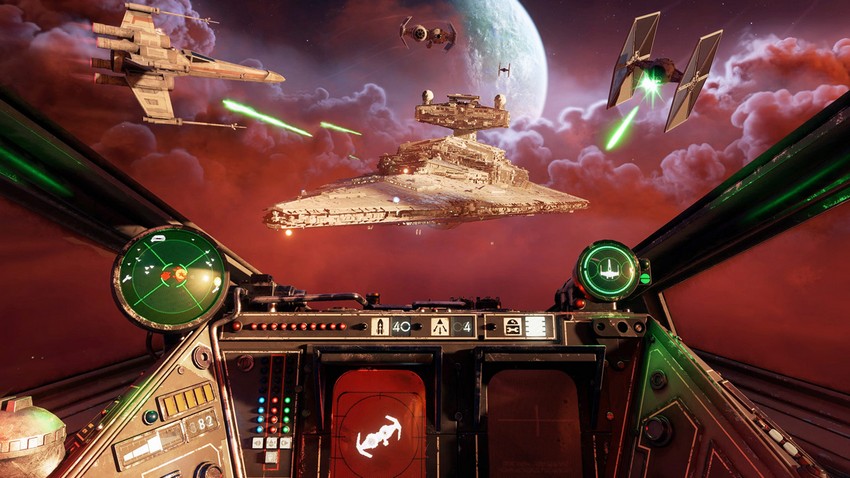
Confession time: I have been dreaming of actually strapping into the cockpit of an Incom T-65B X-Wing starfighter ever since I saw Luke Skywalker use one to blow up the first Death Star in Star Wars: A New Hope. It’s a dream that I’ve held onto for over three decades now, despite being fully aware of how silly, childish, and impossible it is. But over the last few days, that dream felt more than a little real thanks to Star Wars: Squadrons.
Developed by Motive Studios for EA Games, Squadrons is the spiritual successor to Lucasarts’ classic Star Wars TIE Fighter/X-Wing games that I fell in love with in the 1990s. More than that though, it’s the pinnacle evolution of that beloved space flight sim franchise, putting you right in the middle of those spectacular signature Star Wars space battles you gawked at on the big screen like never before.
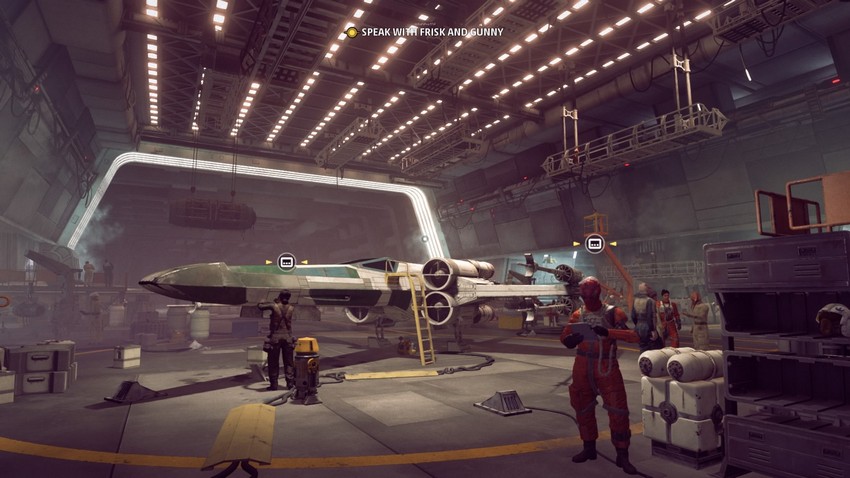
To call Squadrons a stunning game is an understatement as it takes you from one breathtaking corner of this galaxy far, far away to another via capital ship scrapyards, swirling nebulae, the orbit of collapsing moons, and more. Over the course of the eight hours or so it took me to finish the game’s hugely enjoyable 16-mission single-player campaign or the hours since that I’ve put into the thrilling multiplayer, the temptation to frequently just stare at what was outside my cockpit window was ever-present.
And the temptation to stare at the cockpit itself? Even more! Motive has lovingly recreated the insides of some of the most iconic Star Wars spaceships – all-purpose fighters like the X-Wing and TIE Fighter, bombers like the Y-Wing and TIE Bomber, anti-fighter interceptors like the A-Wing and TIE Interceptor, and support vehicles like the U-Wing and TIE Reaper, all with customizable loadouts – giving them all highly intuitive heads-up displays and controls that feed directly into the gameplay.
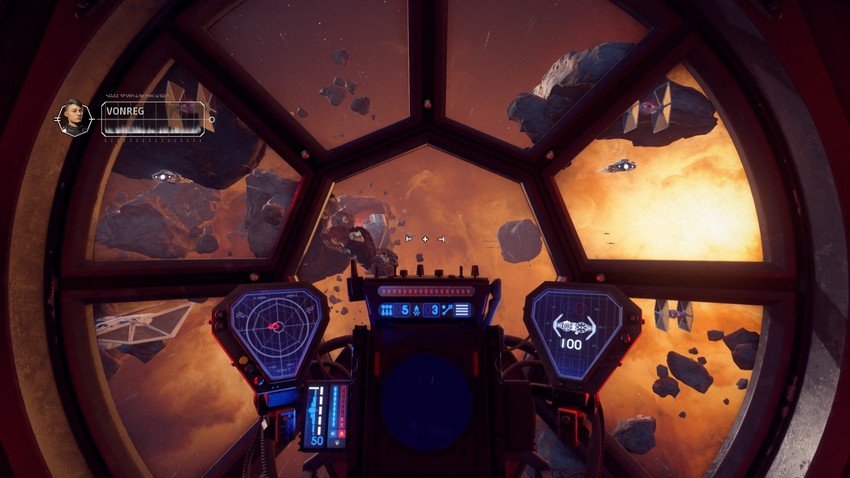
Striking the perfect balance between simulation and arcade, there is a belying depth to piloting these craft. On console, your left stick handles throttling and roll, while your right stick is all about the pitch and yaw. Simple enough. The D-pad is where things get interesting though as you can use it to regulate ship power on the fly between engines, weapons, and shields. You can keep them all evenly balanced or change the preference to one over the other two.
Increase engine power and you get additional speed and manoeuvrability (along with charging a boost that can be used to pull a super cool drift move). Pump more juice into weapons and your primary lasers can fire for longer. Change the balance to shields and your ship’s defences recharge quicker. Max out any of them and you get particular overcharge bonuses. Using the Square button on ships with shields also allows you to change their orientation from forward to backward or balanced, while those without shields (most of the Empire’s lineup) allow you to briefly overcharge engines or weapons even further.
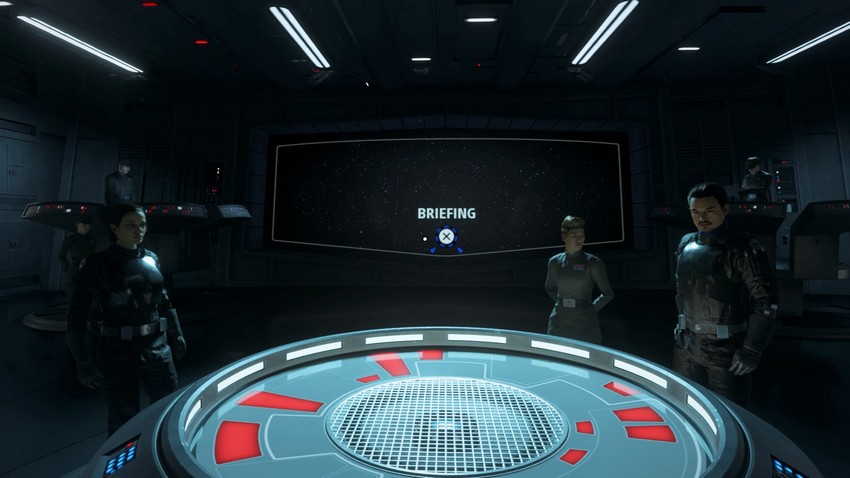
Mastering the balancing act needed to manage all these systems while you are frantically dogfighting through an asteroid field is where Squadron’s complexity comes into play. On top of that, there is the targeting system (accessed via the left trigger) that allows you to cycle through predetermined groupings such as enemy fighters or even capital ship subsystems. Admittedly the targeting can be a bit flaky, as the game will sometimes give you optional objectives to complete that are not in your immediate view space, but with no clear way to quickly mark them, you’re left either cycling through everything or just blindly flying around until you stumble across what you’re looking for. Even with that fumble though, Squadrons absolutely nails what it would feel like to be crammed into one of these vehicles for real.
And if you’re lucky enough to have a VR rig for PC or PSVR kit, then by all accounts it takes that immersion to unprecedented levels as you can freely look out your windows as you buzz the deck of an enemy Star Destroyer, weaving through a web of laser fire as it tries its best to turn you into a fiery cloud of metal and squishy bits. I did not have a VR setup on my PS4 to play Squadrons, and while I’m usually not a man of regrets, this terrible omission has made me question my life choices.
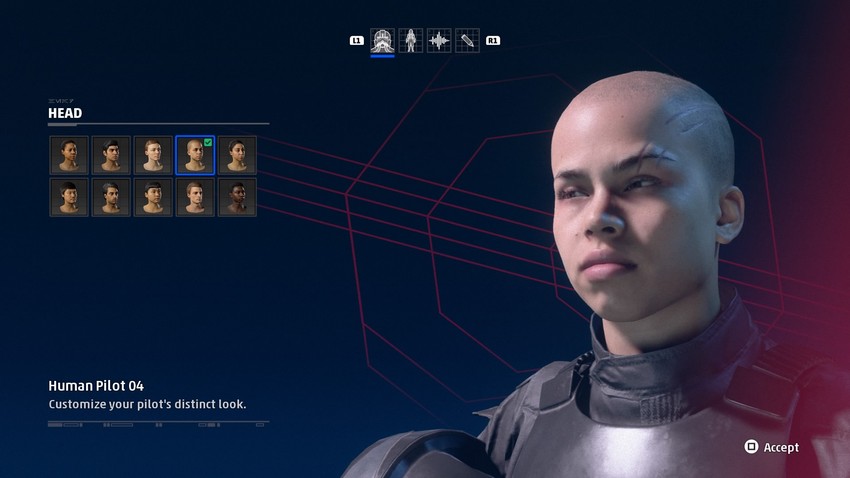
Speaking of choices, there are a few puzzling ones you have to make right from the moment you fire up Squadrons’ single-player campaign, which sees you alternating between playing hotshot young pilots on both the side of the Empire as well as the New Republic. Before you can kick off this story, mostly set in the time following the fall of Emperor Palpatine, you need to customize either pilot’s appearance, voice, and name by picking from a diverse lists of offerings. And I don’t have the foggiest clue why.
Boasting a story that feels like it was ripped right from the pages of the stack of X-Wing novels that weigh down my bookshelf, Squadrons spins a thrilling-enough back-and-forth yarn all centred around Project Starhawk. A super secretive game-changing initiative from the New Republic, Starhawk is under the purview of Commander Lindon Javes, an ex-Imperial Captain who switched sides four years previously when ordered to fire on refugees fleeing the destruction of Alderaan. Trying to uncover what Starhawk is and stop it is Imperial Captain Terisa Kerill, Javes’ former protégé and TIE Fighter squadron second-in-command who is still seething over her mentor’s “betrayal” of the Empire. And to achieve their respective goals both Javes and Kerill will turn to you, the respective new member of the New Republic’s ace Vanguard Squadron and the Empire’s infamous Titan Squadron.
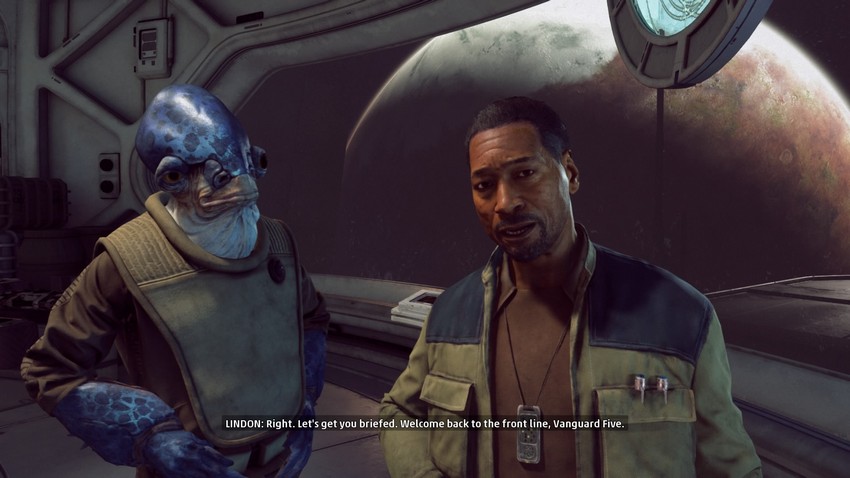
And this is where my previous puzzlement about character creation comes in as you virtually never see or hear your actual character. When not in the cockpit, the story is advanced by you chatting to your various squadmates in the ship hangar or attending mission briefings in the briefing room. And all of this boils down to a stationary POV from which you look around and then click on somebody to talk to, prompting them to go into a completely one-sided conversation with you which is supposed to build the backstory of these supporting cast members but really just felt like pointless filler.
With absolutely zero agency on your side – would a dialogue tree or two in which your character actually spoke have hurt? – you’re a passive passenger in this narrative despite being constantly praised as the one turning the tide for their respective units. The lows of these sections bog down the euphoric highs experienced when you get back into that cockpit – and there are some proper “WOW!” moment setpieces that Motive cook up for the campaign.
There is one way to avoid all those dreary conversations though: Multiplayer!

While clearly the star of the show, in a surprisingly limited design decision there are currently just two modes on offer: Dogfight and Fleet Battle. The former is a straight 5-vs-5 spaceship deathmatch. You pick your preferred starfighter, spawn in, and try to shoot down the enemy pilots as you dive and swoop around each other and one of the half dozen or so maps on offer. First team to 30 kills wins. Done. Fantastic for short bursts of adrenalizing fun.
Fleet Battle is the big-ticket though, a multi-staged tug of war that will require all the skills you’ve picked up in the rest of the game. Matches start out as a simple 5-vs-5 dogfight again, but now with added AI pilots bolstering ranks. Shoot down an enemy pilot and you earn your side some Morale with more allocated for actual players taken out than AI pilots. Shoot down enough to fill the Morale meter at the top of your screen and your team pushes forward to the next stage to assault two capital ships, usually in the forms of frigates or corvettes. Capable of dishing out considerable damage and soaking up even more due to their shields, they will require some skilled attacks. Knock them down though, and you’ll move forward once again to within striking distance of the enemy flagship, a deadly behemoth that will need to have its subsystems – Targeting, Power Core, and Shield Generator – taken out separately if you even hope to stand a chance.
And you have to do all of that while flying through quad laser bombardments and swarms of enemy fighters trying to push you back. And they can. If the defending side shoots down enough attackers to fill up their Morale meter again before the attackers complete their particular objective, the battle swings back the way it came.
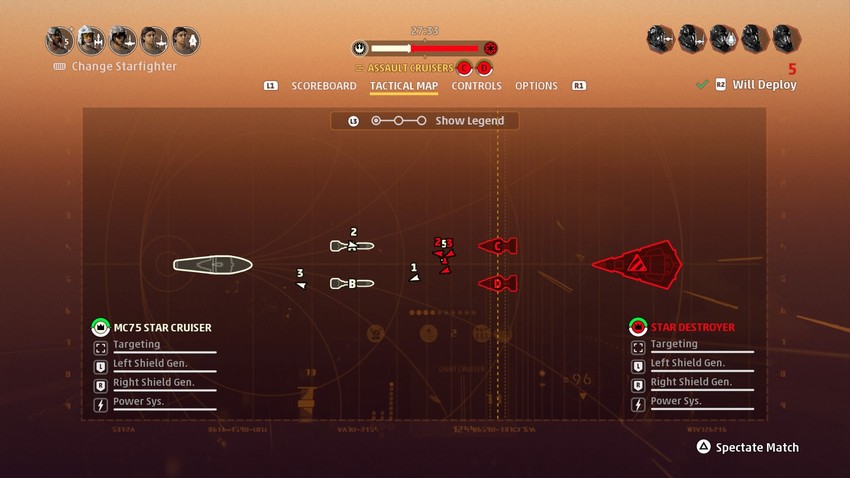
A successful push all the way to the destruction of an enemy flagship will require a serious level of coordination and teamwork. Field too many fighters, and you won’t have the ordnance to take out the bigger ships. Roll out too many bombers and the zippy enemy fighters will cut the slower craft to ribbons. It’s here where I discovered the unexpected thrill of essentially playing a medic in a spaceflight sim, as I used my U-Wing to repair, shield, or resupply teammates – a considerably nerve wracking feat when everybody is also trying to blow you out of the sky.
One white-knuckled back-and-forth game I played exemplified just how well the system could work though as two teammates in A-wings engaged enemy fighters while another in an X-Wing flew in under the enemy Star Destroyer’s shields to knock out a string of automated turrets. That gave a friendly Y-Wing a clear entry path with me flying in its baffles and shielding it from enemy fighters long enough for it to line up a crippling bombing run that snapped the spine of that arrow-headed monstrosity and won us the game. I whooped louder than a Wookiee at that victory. A victory I shared with two friends playing on PS4, and another using VR on PC as Squadron’s crossplay also works seamlessly using EA Account IDs and a surprisingly solid in-game chat to coordinate parties.
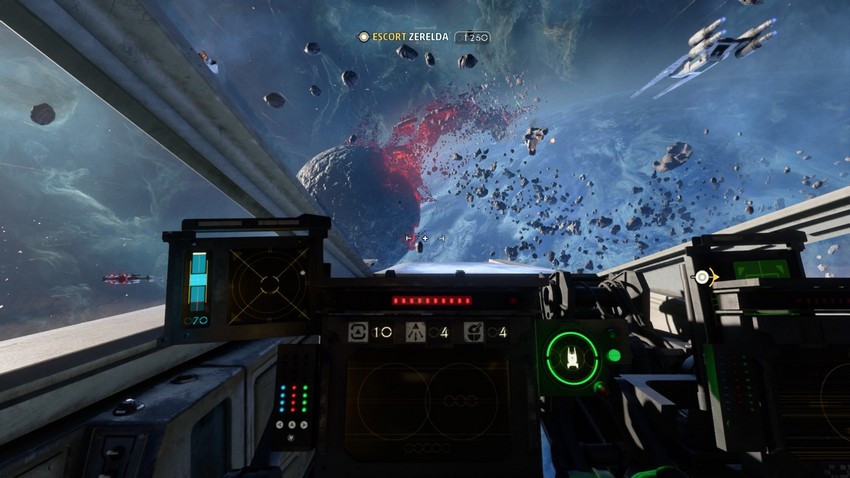
But as great as all of that is, you have to feel that there should be more. Engaging in multiplayer, complete with daily and seasonal challenges, will earn you the in-game currencies of Requisition and Glory. The former can be used to unlock components to customize loadouts, while the latter is for purchasing cosmetics such as spray jobs and decals for your ships, and outfits and gear for your pilot. With no microtransactions at all to speak of (it would appear that EA and Motive learnt their lesson with the disastrous MTX-riddled launch of Star Wars: Battlefront II), these currencies are the only way to unlock in-game elements and you earn them rather liberally as you level up. As such, additional content simply must be on its way to keep busy the gamers who will inevitably reach the game’s level 40 cap in a matter of weeks, if not days. Right now though, there’s no word yet from Motive of any extra releases on the horizon, which is worrying.
A selling price of just $40 (around R700 locally) does admittedly make this less-beefy content offering easier to swallow. However, the biggest issue with Star Wars: Squadrons is that, besides for a couple of niggles, what is on offer here is so damned good that you will almost certainly want more of it right away!
Last Updated: October 7, 2020
| Star Wars: Squadrons | |
|
Star Wars: Squadrons certainly has a few issues. Its enjoyable campaign has some dull moments outside of the cockpit and the multiplayer, as stupendously thrilling as it is, is a bit too barebones at the moment. But it's also the most fun and immersive Star Wars flight sim experience we've ever had thanks to its immaculate gameplay and incredibly polished production. Play this game, you must!
|
|
|---|---|
|
79 /
100
| |





















For the Emperor!
October 7, 2020 at 11:38
Will have to delay this due to Baldur’s Gate 3. But hearing so many good thinks is a positive sign!
Original Heretic
October 7, 2020 at 12:29
Sweeeeet.
Banana Jim
October 7, 2020 at 14:50
Sounds like the perfect monthly free game for PSN+